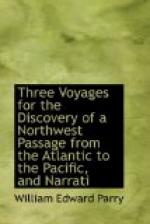Our plan of travelling being nearly the same throughout this excursion, after we first entered upon the ice, I may at once give some account of our usual mode of proceeding. It was my intention to travel wholly at night, and to rest by day, there being, of course, constant daylight in these regions during the summer season. The advantages of this plan, which was occasionally deranged by circumstances, consisted, first, in our avoiding the intense and oppressive glare from the snow during the time of the sun’s greatest altitude, so as to prevent, in some degree, the painful inflammation in the eyes called “snow blindness,” which is common in all snowy countries. We also thus enjoyed greater warmth during the hours of rest, and had a better chance of drying our clothes; besides which, no small advantage was derived from the snow being harder at night for travelling. The only disadvantage of this plan was, that the fogs were somewhat more thick by night than by day, though even in this respect there was less difference than might have been supposed, the temperature during the twenty-four hours undergoing but little variation. This travelling by night and sleeping by day so completely inverted the natural order of things, that it was difficult to persuade ourselves of the reality. Even the officers and myself, who were all furnished with pocket chronometers, could not always bear in mind at what part of the twenty-four hours we had arrived; and there were several of the men who declared, and I believe truly, that they, never knew night from day during the whole excursion.[020]




